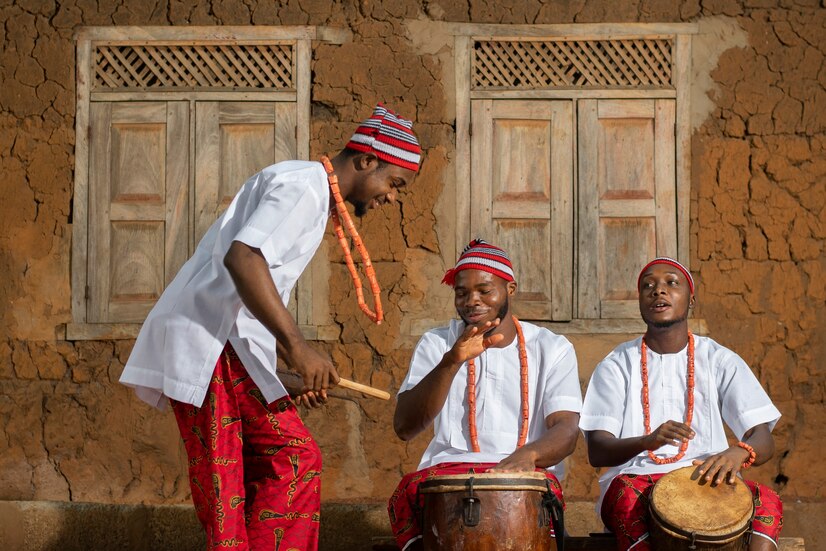Unveiling Amaziğ: Exploring North Africa’s Indigenous Culture
Introduction to Amaziğ
The Amaziğ, otherwise called the Amazigh public or Berbers, are the native occupants of North Africa. Their presence traverses across a few nations including Morocco, Algeria, Tunisia, Libya, and stretches out into parts of Mali, Niger, and Mauritania. Regardless of the different outside impacts they have seen over hundreds of years, the Amaziğ have preserved a rich social legacy that keeps on characterizing the district’s verifiable and social scene.
Origins of the Amaziğ People
The historical backdrop of the Amaziğ public goes back millennia, with their reality being followed to old times. Accepted to be the first occupants of North Africa, their social legacy has fundamentally molded the locale’s set of experiences. Their beginnings remain to some degree baffling, entwined with stories of ancient times and different antiquated civilizations.
Ancient Roots
The Amaziğ public have been involved in North Africa since ancient times. Archeological proof proposes their existence in the area for more than ten centuries, making them perhaps of the earliest pioneers. Since the beginning of time, they have endured floods of relocation, attacks, and social trades, keeping up with their unmistakable personality in the midst of the evolving tides.
Influence of Indigenous Cultures
Regardless of hundreds of years of outer impacts from Phoenician, Roman, Middle Easterner, and European developments, the Amaziğ public have effectively safeguarded their exceptional language, customs, and customs. This flexibility highlights their capacity to keep a particular social personality notwithstanding constant change and outer tensions.
Language and Culture
One of the most characterizing highlights of the Amaziğ public is their language, Tamaziğt, frequently alluded to as Berber. This language bunch incorporates different firmly related dialects and lingos spoken across various Amaziğ people groups in North Africa.
Diversity of Amaziğ Languages
The Tamaziğt language displays critical variety, with various lingos spoken in various districts. Regardless of this phonetic assortment, these tongues share normal elements that tight spot them together, mirroring the social solidarity among the Amaziğ public.
Cultural Traditions
The Amaziğ public boasts a rich social legacy that incorporates music, dance, craftsmanship, food, and customary services. These social practices are basic to their character, went down through ages, and assume an essential part in saving their legacy.
Identity and Heritage
The Amaziğ public invest wholeheartedly in their character and legacy, which are profoundly entwined with the land they occupy and the verifiable encounters they have persevered. Their battle for acknowledgment and conservation of their way of life says a lot about their versatility and assurance.
Struggles for Recognition
From the beginning of time, the Amaziğ public have confronted minimization and mistreatment, especially during pioneer rule and under tyrant systems. Notwithstanding these difficulties, they have kept on battling for their social and semantic freedoms, making progress toward acknowledgment and balance.
Contemporary Issues
In present day times, the Amaziğ public keep on supporting social and phonetic privileges, as well as more noteworthy political portrayal and financial open doors. Their endeavors mirror their strength and assurance to protect their legacy and work on their occupations.
Contributions to Society
The Amaziğ public have made huge commitments to the social, etymological, and authentic scene of North Africa and then some. Their impact is clear in different parts of society, including writing, design, agribusiness, and customary information.
Art and Literature
Amaziğ craftsmanship and writing are rich with their one of a kind perspective, values, and encounters, giving significant bits of knowledge into their social legacy and personality. Customary narrating, verse, and oral chronicles assume a critical part in saving their social stories.
Sustainable Practices
The Amaziğ public have created feasible practices for living together as one with their current circumstance. Their customary rural strategies, water board frameworks, and protection techniques are a demonstration of their profound association with nature and their creative ways to deal with supportability.
Historical Background
The authentic setting of the Amaziğ culture extends far into the past. The old North African individuals known as the Amaziğ, or Berbers, have made a permanent imprint on mankind’s set of experiences. Their set of experiences is a demonstration of their strength and flexibility despite different outside impacts.
Origins
The specific beginnings of the Amaziğ public are as yet bantered among antiquarians and researchers. A few speculations recommend that they plunged from old Egyptians, while others accept they started from the Middle East or even Europe. Nonetheless, most specialists concur that their presence in North Africa can be followed back to something like 10,000 B.C.
Early Civilization
The Amaziğ were among the principal gatherings to lay out coordinated social orders in North Africa. They were gifted agriculturists and herders, known for building invigorated settlements and creating progressed rural methods. Their general public was matrilineal, with ladies assuming critical parts in navigation and administration.
Influence of Ancient Civilizations
Over the long haul, the Amaziğ public connected with different old human advancements, including the Phoenicians, Greeks, Romans, and Bedouins. These collaborations enormously affected their way of life and language, yet they didn’t delete their unmistakable character. The Carthaginians, for example, acquainted them with sea exchange and extended their impact along the Mediterranean coast.
Islamic Conquest
In the seventh century Promotion, Middle Easterner Muslim armed forces vanquished North Africa, carrying Islam to the district. This prompted a combination of Middle Easterner culture with Amaziğ customs, bringing about a novel social mix found in current North African social orders.
Colonialism
During European expansionism in the nineteenth hundred years, numerous Amaziğ people groups had to migrate by French or Spanish specialists. This dislodging prompted social concealment and endeavors at osmosis into Western standards. Nonetheless, the Amaziğ public have figured out how to safeguard their legacy through oral practices, music, narrating, and conventional artworks.
Language, Literature, and Art
The Amaziğ public have a rich social legacy based on their language, writing, and craftsmanship. In spite of confronting concealment, their language, Tamaziğt, has endured, filling in as an image of their personality. Oral narrating, especially as verse, makes light of a critical job in passing practices and values. Music, dance, and customary artworks likewise add to their social articulation, exhibiting their flexibility and pride in their novel lifestyle.
Customs, Traditions, and Beliefs
The traditions, customs, and convictions of the Amaziğ public are well established in their daily existence and assume a huge part in safeguarding their social personality.
Traditions
The Amaziğ public have areas of strength for any local area and are worth getting-togethers. One of their most significant customs is gathering for feasts with loved ones, giving a chance to holding, narrating, and passing down oral practices. Tattoos likewise hold extraordinary importance in their way of life, representing strength, valiance, and magnificence.
Beliefs
Most of the Amaziğ public follow Islam; notwithstanding, they have incorporated numerous pre-Islamic convictions into their religion. They practice animism, accepting that spirits exist inside all things, including creatures, trees, waterways, and mountains. Numerous traditions are as yet drilled today to avert detestable spirits or bring best of luck, mirroring their profound association with their familial convictions.
Geographic Distribution
Throughout the span of centuries, the Amaziğ public have cultivated a socially rich and changed climate in districts including Algeria, Tunisia, Libya, Mali, Niger, and Burkina Faso. Their presence is natural for the personality of these scenes, where they have left an enduring engraving through their customs, language, and local area life.
Religious Diversity
Mirroring the assortment in their social foundation, the strict scene of the Amaziğ public is set apart by a different exhibit of convictions and ceremonies. Before the coming of Islam, the Amaziğ rehearsed native religions with special ceremonies and customs. At the point when Islam spread across North Africa, numerous Berbers switched over completely to Islam, prevalently embracing the Sunni branch, however there are varieties, including some Shia people group.
Contemporary Significance
The pertinence of Amaziğ in current times goes past its exacting interpretation; it captures an entire lifestyle and goes about as an image regarding ethnic variety and narrating customs. By investigating the intricacies of Amaziğ culture, one can acquire a more profound comprehension of the world’s assorted embroidery, encouraging sympathy and appreciation for various civilizations.
Conclusion
Amaziğ culture represents a vibrant and resilient indigenous culture with a rich history and heritage. Despite facing challenges throughout history, the Amaziğ people continue to preserve their identity, language, and traditions, contributing to the cultural diversity and richness of North Africa and the world. Their customs, traditions, and beliefs are a fundamental part of their identity, preserved for centuries, demonstrating their resilience and determination in maintaining their unique cultural identity in North Africa.
FAQs:
What does the term “Amaziğ” mean?
The term “Amaziğ” refers to the indigenous ethnic group native to North Africa, also known as the Amazigh people or Berbers.
Where are the Amaziğ people located?
The Amaziğ people are primarily concentrated in countries such as Morocco, Algeria, Tunisia, Libya, and parts of Mali, Niger, and Mauritania.
What languages do the Amaziğ people speak?
The Amaziğ people speak Tamaziğt or Berber languages, which encompass a group of closely related languages and dialects.
What are some traditional cultural practices of the Amaziğ people?
Traditional cultural practices of the Amaziğ people include music, dance, art, cuisine, and various ceremonies that celebrate their heritage and identity.
What challenges do the Amaziğ people face in contemporary society?
The Amaziğ people face challenges such as marginalization, discrimination, and struggles for recognition of their cultural and linguistic rights in contemporary society.
Are Algerians Arab?
Although many Algerians identify as Arab, the country is home to a diverse population that includes significant Berber minorities. Most Algerians are thought to be of Arab-Berber origin due to the strong influence of Arab culture and language.




